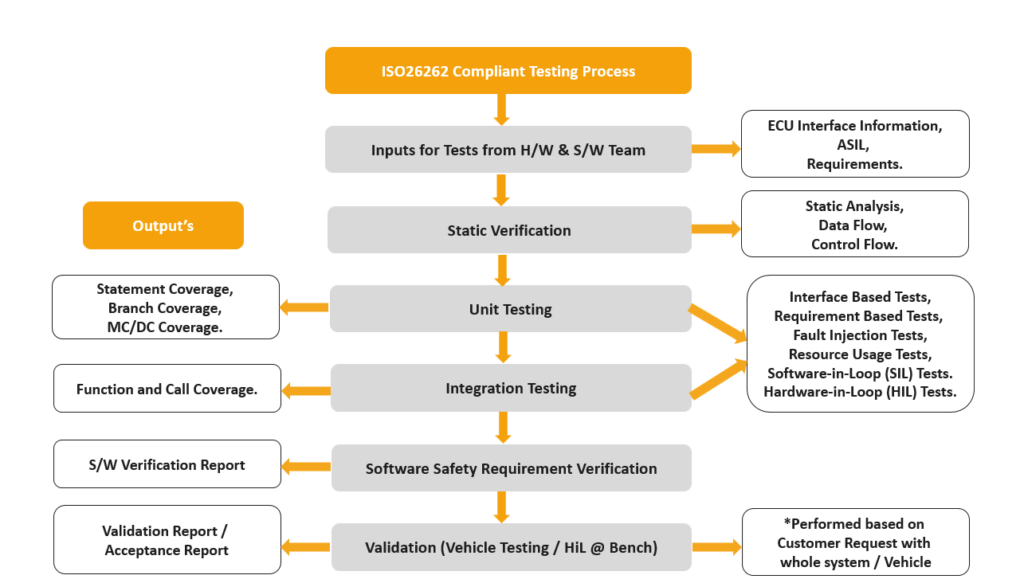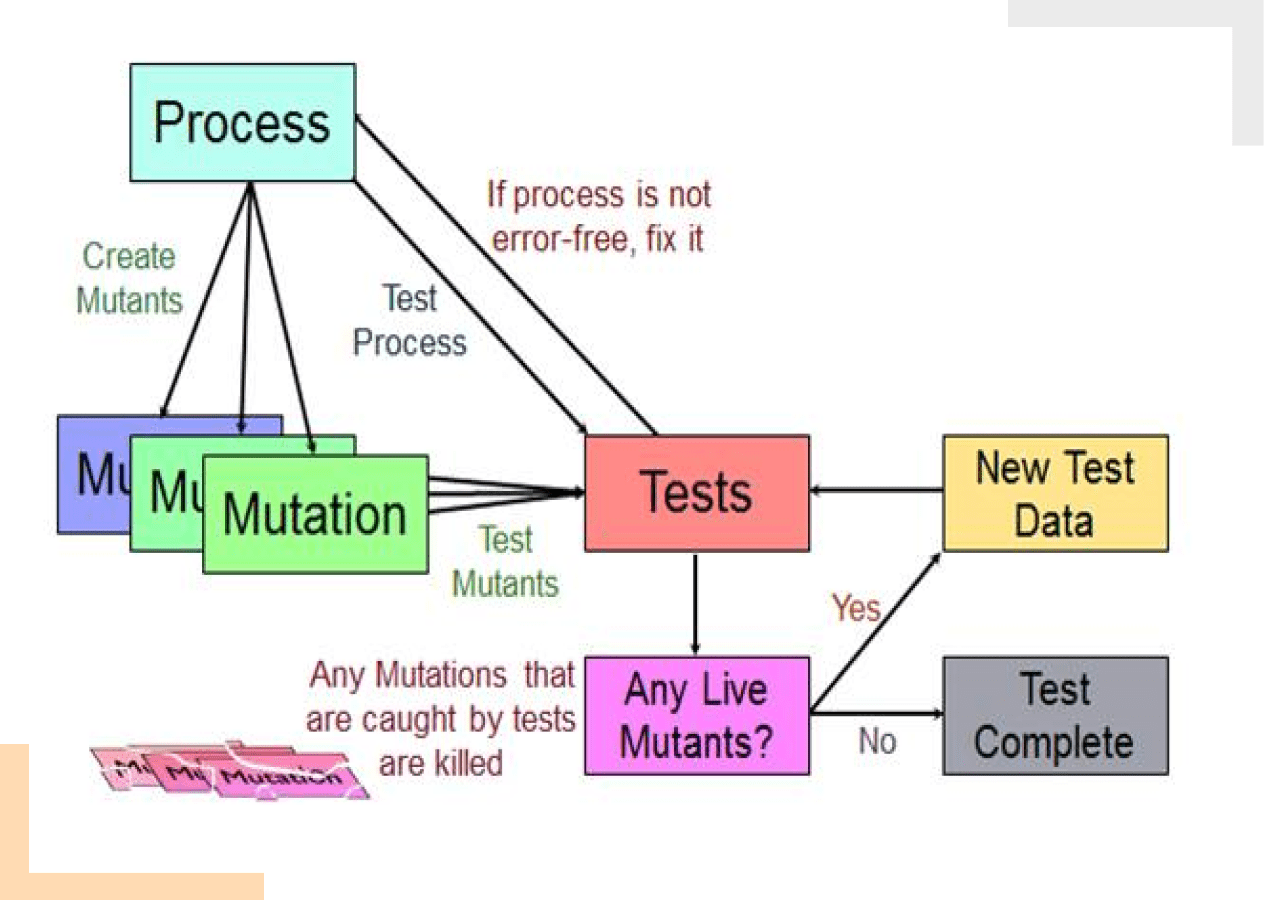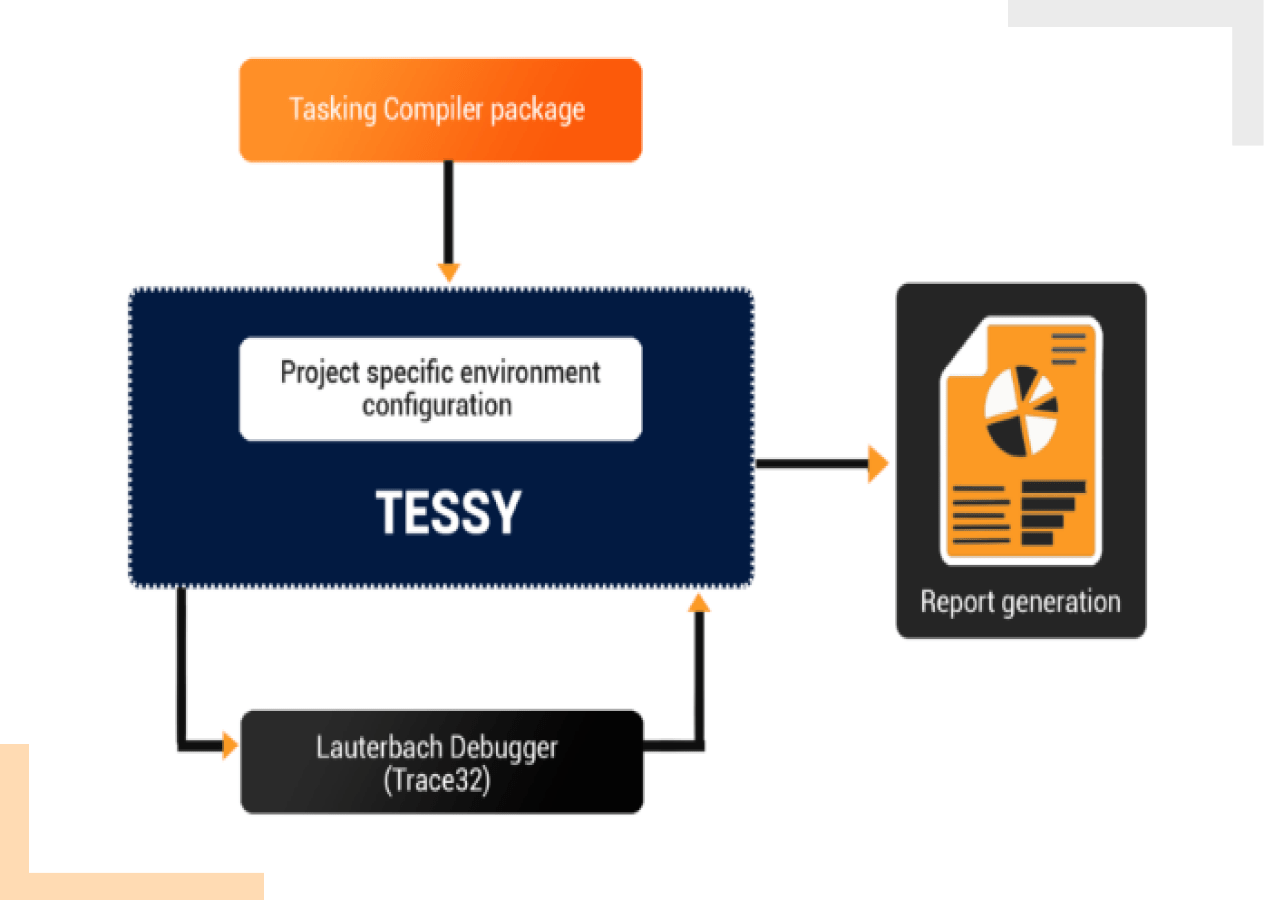ISO 26262 Compliant
Automotive ECU Testing
Validation and Verification of automotive software as per ISO 26262 standard is the key to ISO 26262 compliance and certification.
Part 6 and Part 8 of the ISO 26262 standard mentions the various software testing methodologies to be implemented according to the targeted ASIL values. Our ISO 26262 testing services are designed to follow these methodologies and to automate the testing activities using ISO 26262 qualified tools such as CANATA, Tessy, RTRT etc.
Verification and Validation Best Practices for ISO 26262 Compliance
Automation of
Testing Activities
We achieve faster turn-around time for our customers by deploying ISO 26262 qualified tools like Tessy, CANTATA, RTRT and others
Tool
Qualification
Tool classification qualification process is rigorously implemented for safety-critical automotive projects.
Bi-directional
Traceability
Bi-directional traceability between software requirements and test cases is an integral part of ISO 26262 compliance. We follow across the safety-lifecycle
Work products as
evidence
Every safety lifecycle activity generates work products. We document and record it meticulously and provide to our customers.
Integration of ISO 26262 complaint testing with ASPICE and Automotive Cybersecurity
ASPICE is being embraced by all automotive stakeholders. As technology partners, we help you develop ISO 26262 compliant solutions simultaneously following the ASPICE processes. At every stage of V-cycle, certain analyses recommended by ISO 26262 standard are performed alongside ASPICE processes. For instance, a hazard analysis (HARA) is performed as an extension to risk management (ASPICE).
Our cybersecurity (ISO 21434) and Functional safety (ISO 26262) teams work in tandem to help you build solutions safety-critical solutions with cybersecurity functionalities. From requirement traceability, coding compliance and structural coverages to tool qualification and code verification, FuSa and cybersecurity experts work together to achieve compliance to both ISO 26262 and ISO 21434.
Customer Success Stories
ISO 26262 ECU Testing: The Process Flowchart

A Handbook on ISO 26262 Compliant Testing:
Learn more about Unit, Integration and Functional Testing methodology as per ISO 26262 standard
Download PDF
Expertise in ECU Testing Tools Certified by ISO 26262
We have expertise in the following Testing and Verification tools. These include tools certified by ISO 26262 standard and others.
- CANTATA– Ideal to automate unit and integration testing and ISO 26262 verification of the code. It is an ISO 26262 certified tool.
- RTRT– An Automation tool for unit testing, developed by IBM. It is a widely used testing tool and is certified by ISO 26262.
- Polyspace- This tool uses formal techniques to test run-time errors. It checks for security vulnerability, coding guidelines and other classes of bugs. It is used for static verification process.
- MX-Suite- This is one of the most comprehensive automated testing tools for software verification of embedded systems.
- Tessy Tool for Unit Testing- Tessy automates the whole unit test cycle for Embedded software development project including regression testing” in the section.
Automotive ECU Testing Services: Complaint with the Functional Safety Standard
- Expertise in Unit Testing Services for Automotive Software in accordance with the required Automotive Safety and Integrity Level (ASIL)
- Statement coverage, branch coverage and MC/DC coverage
- ISO 26262 Compliant static verification services including semi-formal verification, control flow analysis etc.
- Expertise in static analysis tools like QA-C and PolySpace
- ISO 26262 compliant integration testing services including fault-injection testing, models and codes simulation and structural coverage.
- Expertise in testing tools like CANTATA, Mx-Suite, RTRT, LDRA and Tessy tool
- Software Safety Requirement (SSR) verification services as per ISO 26262 standard
- Support for SSR verification in ECU network and vehicle-level environment
- Hardware in Loop (HIL) Testing
[Video] Functional Safety and Unit Testing: Decoding Part 6.9 of the ISO 26262 Standard
FAQs Regarding ISO 26262 Compliant ECU Testing Services
Ans. Primarily, we partner with the customers based on the “Time and Material” business model. The billing is charged based on the actual man hours and cost of equipment (3rd party tools etc.) for the project.
However, once the project and relationship mature and we gain deeper understanding of the code complexities, tool requirements and future changes, the business model can be changed to “fixed price model”.
Ans. The following is the indicative list of the testing tools that we have worked with, during ISO 26262 testing projects are as follows:
- CANTATA for Unit and Integration Testing
- MX-Suite for unit testing and software verification of embedded system
- RTRT for Unit Testing
- Polyspace to check coding guidelines and static verification process
- Tessy tool for automation of unit testing actvities as per ISO 26262 standard
Our hands-on experience of working on these tools include projects on different ECUs. We can share more details once we sign the NDA.
Ans. The security and integrity of the code is our number one priority, as per the NDA signed with our customers.
We adhere to the GDPR and ISO 27001 guidelines for the code safety and integrity.
Secure FTP is also always made available, to ensure that code is transferred in a secure environment.
Ans. When you partner with Embitel, for ISO 26262 compliant testing services, you collaborate with an expert core team of:
- Functional Safety Consultants
- Project Managers
- Testing Engineers.
Here is the team hierarchy that is most commonly followed in the ISO 26262 Testing Projects.
Functional Safety Manager: Ensures that the ISO 26262 testing guidelines are followed in letter and spirit, during the testing processes. For all the technical discussions, the Functional Safety Manager will be your SPOC.
Project Manager: Manages the entire project execution and coordinate between the team and the customers.
Testing Engineers: Collaborate for Unit Testing, Integration Testing and Validation activities
Ans. We do have an onsite/offshore business model, in which we provide resources to our customers for testing projects.
Our engineers travel to the customer’s location to perform software testing. This is usually opted when the customers have certain tools or environments specific to the project.
Alternatively, the customers can also set up an off-shore development center (ODC), where they can send the work-products for testing, under a secure environment.
We will perform the tests and share the report within a stipulated span of time. We will ensure that a secure communication infrastructure is created to protect the integrity of the code.
Ans. Following reports will be provided, as deliverables of ISO 26262 Testing Project:
- Unit Test Reports, Integration Testing Reports, etc.
- Tool reports from tools like CANTATA, MX-Suite etc.
If the customers require the reports in any specific test template, we can support for the same.
Ans. We share weekly or monthly Timesheets with the customers to keep them apprised of the developments in the project. The timesheet covers the completed processes, pending activities, health of the project etc.
The project managers also have regular calls with the customers to give the heads-up on the project. This is how the communication channel is maintained and project is supervised.
Related Blogs: Learn more about ISO 26262 ECU Testing and Verification of Automotive ECU
- [Vlog] ISO 26262 Compliant Unit Testing: Understanding the Methods, Test Cases and Coverage
- ISO 26262 Compliant Unit Testing Strategies: A Step Towards Achieving Functional Safety in Automotive Product Development
- How vTest Studio and CANoe Tools Empower the Automation of ECU (Electronic Control Unit) Testing
Knowledge bytes
The dimension of ISO 26262 mandated functional safety is added to the testing process when the final automotive solution must be ASIL compliant. ISO 26262 standard specifies certain guidelines in parts 6.9, 6.10, and 6.11 that must be followed during the unit testing, integration testing and static verification process of automotive ECUs.
The ISO 26262 standard emphasizes on the inputs and output of the testing process but does not recommend any specific way of performing the tests. However, it does recommend certain certified tools like CANTATA for the purpose.
What is CANTATA tool? How does it help in ISO 26262 ECU Testing Projects?
CANTATA is a unit and integration testing tool that enables the developers to verify the code against standards such as ISO 26262.
CANTATA is one of the ISO 26262 certified testing tool that helps meet testing requirements laid down by ISO 26262 standard. It is the recommended ECU testing tool in scenarios where the automotive product is aiming for Automotive Safety and Integrity Level (ASIL B, ASIL C or ASIL D) certification.
CANTATA automates the following ECU testing activities to accelerate ISO 26262 compliance process:
- Generation of Test Frameworks
- Test case generation
- Execution of test cases
- Test report generation
Which are the tools other than CANTATA which aid the developers in ISO 26262 Compliant ECU testing?
During automotive software development, different kinds of tests and verifications are carried out viz, unit testing, integration testing, static analysis, dynamic analysis, design verification etc. There are certain specialized tools for all these testing and verification activities. Following are some widely used ECU testing tools:
- PoySpace- The tool serves dual purpose. First, it helps in static code analysis in order to detect any run-time error in C code. Second, it checks the source code to ensure the adherence to coding practices and standards such as MISRA.
- RTRT- RTRT is a multi-purpose automation tool for code testing. In automotive ECU testing projects, it is mostly used for unit testing, coverage analysis and system testing. It creates test scripts, test cases and rest reports. It also supports regression testing.
- Tessy is a Test System designed for automated unit and integration testing. Being an ISO 26262 qualified tool, Tessy is ideal for the development of automotive solutions with safety-critical requirements. It automates the entire Unit Testing cycle and also performs the regression testing.
- LDRA- It provides a complete suit to automate the ISO 26262 compliant testing and verification processes. LDRA helps meet these software quality and test requirements:
- Requirement Traceability
- AUTOSAR and MISRA C Compliance
- Statement, Branch and MC/DC coverage
- Model Based Development



